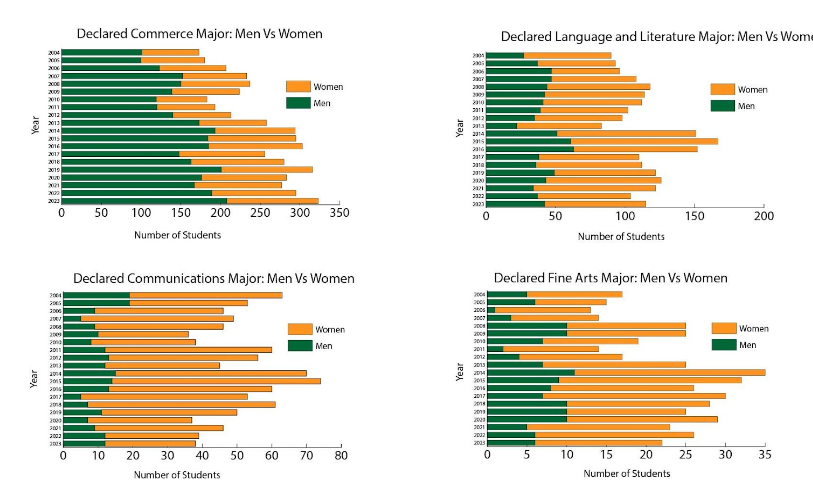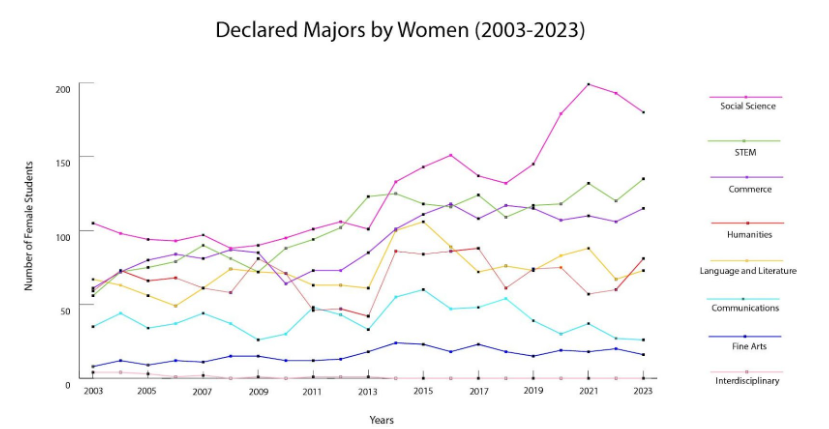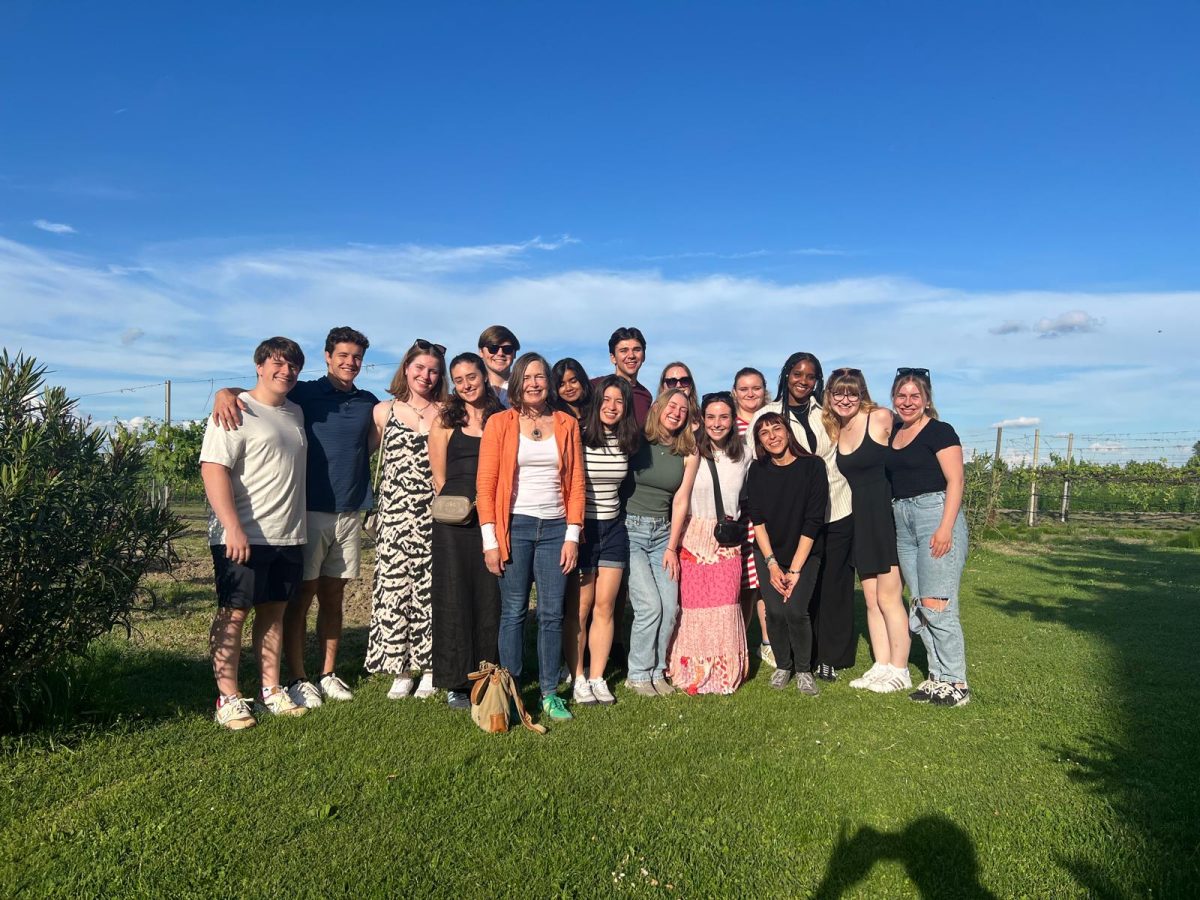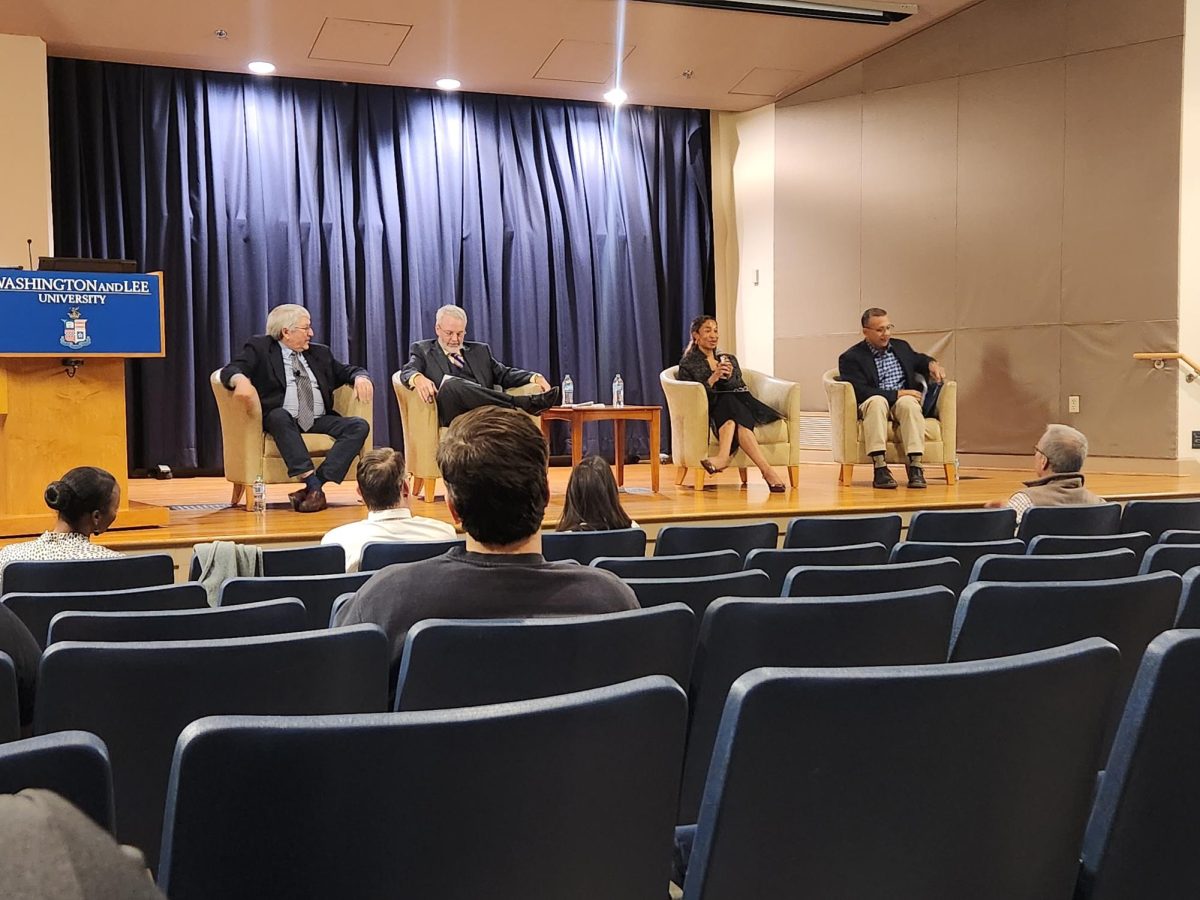Undergraduate female students at Washington and Lee University have preferred similar majors since 2003, according to an analysis of university data.
Majors in the social science field were the most popular among female students in 2023, followed by science, technology, engineering and math (STEM) and business and commerce. Data shows the least number of women major in fine arts or communications, though both majors are women-dominated.
Women first enrolled at Washington and Lee in 1985. The liberal arts college has offered at least 43 different majors since then. For the purposes of this article, majors were categorized into eight options, based on similarities in course frameworks.
In 2003, a little more than 100 women enrolled in social science majors. By 2023, that number had risen to nearly 200. While social science majors have consistently attracted the most women, other fields are on the rise compared to 2003. STEM majors were the fourth-most popular option for women in 2003, but are now the second-most popular, with over 100 women enrolled in these majors.
Remembering the shift to co-education
Data on women’s majors before 1992 wasn’t accessible, and discrepancies were found in numbers dating between 1992-2003, said the university’s institutional research analyst Melanie Mabry. She attributes the inconsistencies to the use of different data-tracking methods at the time.
There were not any restrictions on majors women could enroll in when Washington and Lee became co-ed in 1985. Bennett Ross, ’83, who served as an admissions counselor during the co-ed decision, said women were encouraged to explore their interests in hopes of diversifying academic perspectives.
Women’s enrollment at the university has also changed significantly. Ross said he interviewed the first-ever prospective woman student at Washington and Lee.
“With all due respect, the class of ’88 – the last all-male-class – it was not our strongest in terms of academic qualifications,” said Ross. “I think most faculty were really looking forward to the opportunity to get some vibrant, intellectually stimulating students in the class. Both male and female.”
But Ross said the administration shared concerns on whether classes would be welcoming to the newly-admitted women. The co-ed decision was met with hostility by faculty who opposed it and students still part of the last all-male classes, Ross said.
Only 111 women were enrolled in 1985, followed by 165 in 1986. Ross said there were over 1,000 applicants in the first co-ed class, but admissions limited women enrollment to ensure smooth integration.
Director of the Johnson Program in Leadership and Integrity Elizabeth Knapp graduated in 1990 from Washington and Lee. She was in the second class of enrolled women and one of the few female geology majors.
Knapp notes that class dynamics started to shift during her time at Washington and Lee. She said she faced more rude comments by her male peers earlier on, but the school quickly became welcoming by the time she graduated.
“Even socially that was challenging, sometimes going to parties – if you weren’t a woman from one of the nearby women’s colleges and you said you were from W&L,” Knapp said. “I never felt that in the department, per say, and that’s part of what drew me to it.”
Knapp said that although there were few female students and no women faculty in her major, she felt the most supported by the STEM department.
“I felt like I had a home here. I didn’t always find that in every class that I took here,” Knapp said. “There were faculty who were not as supportive of women here and you sort of avoided that.”
Late professor Jefferson Futch taught history courses until 2008. He was famous for making students wear ties to class and maintained that rule in the early years of the co-ed decision. The rule discouraged women from taking his course, Knapp said.
Female- versus male-dominated majors
While the class of 1988 may have started with only 111 women, the class of 2027 is now majority women. 52% of the class identifies as female.
Since 2004, data shows that some majors have been majority-women: majors in language and literature, fine arts and communication. But commerce majors, which include business and accounting majors, have historically been majority male since Washington and Lee became co-ed.

Angela Tu, ’24, double majors in business administration and Chinese. She said she was intimidated by all the male students when she first started taking her business courses in 2021. At times, she has felt at a disadvantage in her finance classes that are male-dominated.
“A lot of them already came in with the foundation that I don’t think I have ever accessed before,” Tu said. “Either their parents have taught them a little bit, or their private schools offered programs. I just feel like it was just so much more daunting talking in those classes.”
Tu said the business track is becoming more welcoming to women. She said the Career and Professional Development office has started to provide more support and opportunities for women interested in the commerce field.
“There’s actual programs for women shadowing –WIS – or like there’s a women’s New York trip. These things are very influential,” Tu said. “I feel like as soon as those doors open, women would probably feel more inclined to pursue that path.”









